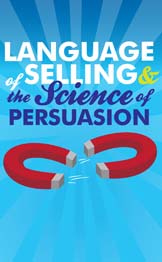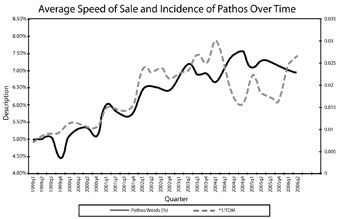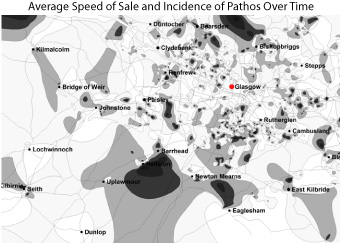Language of Selling and Science of Persuasion
by Professor Gwilym Pryce, PhD (Scotland)
Two and a half thousand years ago the grandfather of modern philosophy set out his thoughts on the science of persuasion:
"Of the modes of persuasion furnished by the spoken word there are three kinds. The first kind depends on the personal character of the speaker; the second on putting the audience into a certain frame of mind; the third on the proof, or apparent proof, provided by the words of the speech itself." (Aristotle, 350 BC, p. 3)
Aristotle labeled these three elements: ethos (reliability of the speaker), pathos (the manipulation of the emotional predisposition of the audience) and logos (logical argument). All attempts to persuade - from a politician seeking re-election to a real estate agent trying her utmost to sell homes in difficult times - can be decomposed into these three essential elements. The most exotic, and of greatest interest, is the second of these components. And pathos, the use of emotive words and hyperbole, is what realtors are most famous for. The idiom of estate agency is seen as its defining characteristic. "Des. Res.", "rarely available", "viewing essential" - these are the grist of the peculiar parlance of housing advertisements that contain a readily identifiable combination of euphemism and superlative. Indeed, many of the jokes about estate agents rest on an accepted set of popular assumptions about their particular use of language as the following extracts from online humorous "dictionaries" demonstrate:
'Bijou': Would suit contortionist with growth hormone deficiency. 'Compact': See Bijou, then divide by two. 'In Need of Modernisation': In need of demolition.
'Internal Viewing Recommended': Looks awful on the outside.
'Original Features': Water tank still contains cholera bacterium. 'Studio': You can wash the dishes, watch the TV, and answer the front door without getting up from the toilet. 'Secluded location': It was in the middle-of-nowhere - barren and desolate. Suitable film set for Mad Max 5.
But should buyers be concerned about realtors' creative abuse of language? Probably not. These humorous dictionaries of estate-agent jargon are testimony to the fact that buyers decode before swallowing the claims of house adverts. One does not actually expect a 'stunning lounge' to render one unconscious or an 'exclusive neighbourhood' to literally screen out undesirable people who want to move to the area. There is a commonly understood language of real estate, one that moves far beyond a mere description of the physical nature of a property (or even a rather one-sided, optimistic version of the attributes). The real question is the extent to which the pattern of pathos varies across housing submarkets and overtime. Applying textual analysis to a unique dataset of 49,926 property adverts, a recent study at the University of Glasgow, Scotland, tests a number of competing and complementary theories regarding how and why we might (or might not) expect the language of estate agency to vary over time and space.
For example, one might reason that estate agents are sufficiently well-established as a profession to have arrived at a common set of communication norms which, in turn, have led naturally to a widely accepted and stable form of marketing language. This uniformity is likely to be reinforced by household mobility and the widespread use of the internet. In the same way that television has been blamed for the cross-fertilization of regional accents, the explosion of web-based property advertising has all but eradicated temporal, regional and intra-urban variation in realtor dialect. This theory suggests that we should not expect any secular, cyclical or seasonal variations in language. On the other hand, as the market booms, new staff are needed to cope with the rising turnover of properties. New employees are typically less experienced and possibly more prone to hyperbole. (Experienced staff know that buyers are not, in the end, duped by excessive exaggeration, and that a judicious approach is more profitable in the long run.) When the market slows, there are insufficient sales to maintain the expanded workforce. Staff are laid-off on a last-in-first-out basis, increasing the share of experienced agents, and leading to a pro-cyclical pattern in the language of selling. This theory would lead us to expect cyclical variation in language, but not regular seasonal or secular patterns. Then there is the theory of irrational exuberance. Market value is not an intrinsic constant, and neither is the propensity to enthuse about property features. A mid-terraced house described as "well-maintained" during the dark valley of a market slump, may become "truly fantastic" at the dizzy heights of a boom. Once the zenith has passed, however, the property is seen for what it is, and more restrained descriptions become the norm. This theory would suggest that particular types of emotive expression - those less grounded in reason - will be more volatile and more sensitive to market swings, but will not affect long-term trends or induce changes over the selling season. We must also consider the strategies employed to market difficult-to-sell properties. Prolonged time on the market occurs because the market is experiencing a downturn or because there are rarely many buyers for houses in that location or of that type. Under these circumstances, agents may adopt a strategy of exaggerating a property's attributes in an attempt to attract interest. During a hot market, properties "sell themselves" so there is less need for strained descriptions. This theory suggests that we should anticipate the incidence of effusive language to fall during a boom and rise during a slump. An opposing theory is one based on the opportunity cost of viewing. The argument goes something like this. No sane person buys a property without viewing, so why should the parlance of property adverts have an effect on whether (and what) buyers are willing to offer? The answer may lie in the forgone opportunities associated with visiting a particular property. Buyers have a fixed (or at least preferred) window of time within which to secure a new home. Even if viewing is something of a disappointment in comparison with the agent's description, house-hunters still have a strong incentive to submit an offer. Turning down a property after viewing introduces the risk that a continued search will not yield a superior alternative within the buyer's timeframe. As far as the estate agent is concerned, viewing is all that is important because it shifts the probability of a buyer submitting an offer from zero to some positive value, and the greater the number of bidders, the greater the expected selling price (see Levin and Pryce, 2006). So, according to this theory, agents know that property adverts are not the basis on which purchases are made - that is not their purpose. Their purpose is simply to attract viewers and increase the potential number of bidders. Language variation occurs when there are changes in the opportunity cost of viewing. While agents may not understand the theory behind the strategic manipulation of language, they will be aware that it is more profitable, at certain times of the year and in certain phases of the cycle, to use emotive terminology. When properties are selling very quickly, the effective range of choice facing a buyer may be very limited. Even though there are many properties coming onto the market, there is also a rapid flow of properties leaving the market. A buyer might view x properties over a particular period, but by the end of that period, only a small proportion of those properties are still available for purchase. Consequently, there is a very strong incentive during such periods to bid for a property as soon as it is viewed, and therefore a very strong incentive for estate agents to use any means possible to get potential buyers to view. The implication of this theory is that we should observe strong seasonal and cyclical variation in the incidence of pathos. Finally, we might also theorise that, given the tendency for local conventions to occur in accents, pronunciation, idiom, and terminology generally, it would be surprising if similar patterns did not occur in the language of selling. Local house moves (which the majority tend to be) foster and preserve a common dialect between estate agents and those in the surrounding community. Elaborate idiosyncrasies evolve because of persistence in the geographical and cultural proximity of the parties involved in the majority of transactions. While moves are infrequent, the interaction between punters and agents is not. Estate agents are engaged in an ongoing process of persuading residents to move. Real estate voyeurism - the propensity of consumers to window-shop - facilitates this ongoing dialogue. This line of reasoning leads us to expect persistence over time in local patterns of language and the use of pathos. So what does the Scottish data reveal? By calculating the proportion of pathos words in each of the 49,926 records of real estate transactions in the West of Scotland over the period 1999 to 2006 the research revealed distinct seasonal variation in the average incidence of pathos, one that bore a distinct correlation with how quickly properties were selling on average at a given time (measured as one over the average number of days on the market).
Click to Enlarge  There was also very strong evidence of geographical concentrations in the use of pathos, demonstrated in the following contour map where the dark regions reveal hot-spots of pathos. These spatial patterns proved to be persistent over time. The line graph below compares two cross sections taken along the same straight line connecting Bearsden and Renfrew, first for 1999 and then for 2005. While the level of pathos had shifted upwards almost everywhere by 2005, the peaks and troughs in the cross section occur at similar points in space. Statistical analysis using fairly sophisticated regression techniques confirmed these findings, controlling for property type and other factors.
There was also very strong evidence of geographical concentrations in the use of pathos, demonstrated in the following contour map where the dark regions reveal hot-spots of pathos. These spatial patterns proved to be persistent over time. The line graph below compares two cross sections taken along the same straight line connecting Bearsden and Renfrew, first for 1999 and then for 2005. While the level of pathos had shifted upwards almost everywhere by 2005, the peaks and troughs in the cross section occur at similar points in space. Statistical analysis using fairly sophisticated regression techniques confirmed these findings, controlling for property type and other factors.
Click to Enlarge Geographical Variation in the Incidence of Pathos in 1999  So, what has an application of Aristotle's science of persuasion to realtor adverts told us? A peak into the language of estate agency has revealed a world rich with local conventions and seasonal variation, complex mesh of idiom and hyperbole, interacting with submarkets, selling times, opportunity costs and irrational exuberance. The internet may have transformed the way we buy and sell houses but it has done nothing to suppress the linguistic creativity of those whose passion and profession is the selling of homes.
So, what has an application of Aristotle's science of persuasion to realtor adverts told us? A peak into the language of estate agency has revealed a world rich with local conventions and seasonal variation, complex mesh of idiom and hyperbole, interacting with submarkets, selling times, opportunity costs and irrational exuberance. The internet may have transformed the way we buy and sell houses but it has done nothing to suppress the linguistic creativity of those whose passion and profession is the selling of homes.
. . . . . . . . . . . . . . . . . . .
References:
Levin, E.J. and Pryce, G. (2007) 'A Statistical Explanation for Extreme Bids in the House Market', Urban Studies, 44:12, pp. 2339-2355. Pryce, G. and Oates, S. (2008) "Rhetoric in the Language of Real Estate Marketing", Housing Studies, Volume 23, Issue 2, March 2008, pages 319-348.
. . . . . . . . . . . . . . . . . . .
About the Author:
Gwilym Pryce, PhD Professor of Urban Economics and Social Statistics
Department of Urban Studies,
University of Glasgow, Scotland
Gwilym currently leads the Cities, Markets And Regions Research Group and the Urban Resilience Research Cluster in the Department of Urban Studies, and is Director of SHEFRN (Scottish Housing Economics and Finance Research Network). His work spans a wide spectrum from highly technical/theoretical work published in leading international academic journals in his field (such as Real Estate Economics and Journal of Urban Economics), to applied policy reports for government departments. His work has been cited in major policy reports (such as the HM Treasury Barker Review of Housing Supply, 2003) and in high-level commercial documents (such papers prepared for the Basel conference of Central Bank Economists in 2003). His paper "Social Segmentation, Housing Submarkets and Dwelling Substitutability" recently won the The Hypotecní Banka Award for the best European Network of Housing Research 2009 Conference Paper. Gwilym has been an expert advisor at a senior policy level in Central Government (to the Minister for Housing and Planning - on Housing Wealth Inequality, and to the Treasury Review of Housing Supply). He has also been appointed to the Expert Panel on Planning and Housing (UK Department of Communities and Local Government).